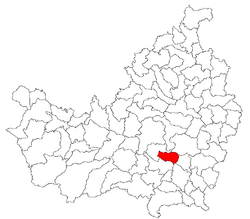Aiton, Cluj
| Aiton | |
|---|---|
| Commune | |
 Location of the settlement on County map |
|
| Location on Romania map | |
| Coordinates: 46°41′07″N 23°44′20″E / 46.68528°N 23.73889°ECoordinates: 46°41′07″N 23°44′20″E / 46.68528°N 23.73889°E | |
| Country |
|
| County | Cluj County |
| Status | Commune |
| Settled | 1320 |
| Commune seat | Aiton |
| Villages | Aiton, Rediu |
| Government | |
| • Mayor | Făgădar Nicolae (PSD) |
| Area | |
| • Total | 45.27 km2 (17.48 sq mi) |
| Elevation | 626 m (2,054 ft) |
| Population (July 1, 2007) | |
| • Total | 1,244 |
| • Density | 27/km2 (71/sq mi) |
| Time zone | EET (UTC+2) |
| • Summer (DST) | EEST (UTC+3) |
| Postal Code | 407025 |
| Area code(s) | +40 x64 |
| Website | http://www.cjcluj.ro/aiton/ |
Aiton (Hungarian: Ajton; German: Eiten) is a commune in Cluj County, Romania. It is composed of two villages, Aiton and Rediu (Rőd).
Mean altitude: 626 m (2054 ft).
The presence of large deposits of halite and saltwater springs within the perimeter of the commune have been identified.
Traces of several ancient neolithic settlements (of which Vinča culture from the 4th millennium BC), as well as evidence indicative of the Bronze Age, the Iron Age, the Roman conquest, and the Migration Period, were discovered in the village. Within the surrounding area, a tomb of incineration from the 1st century BC and a rustic villa have also been found; the latter in which a Dacian fruit tree from the 2nd century BC has been discovered.
During the Roman period, the locality was situated on the Roman road of Potaissa-Napoca. Initially, a portion of the commune was left uncovered in the yard adjacent to the school, marked by a colonette reproducing the inscription on the milestone of 108. As of 2017, however, the site is covered in waste products. The area was historically the center of a Spanish equestrian unit.
The first documented reference to the village of Aiton with the name Villa Ohthunth dates back to 1320, and in 1329, the toponym of Ahthon was attributed to the settlement. Since 1456, it appears under the current name of Ayton. In 1658, the locality was burned, following a Turkish and Tatar invasion.
In the 18th century, a milestone named Aiton Biliar from the Roman period was discovered. This marked a distance on the Potaissa-Napoca. The landmark attests the existence of a road built in 108 AD by the cohors I hispanorum miliaria. A copy of this landmark is displayed in Turda, yet another is displayed in front of the school of Aiton.
On the Josephine Map of Transylvania from 1769 to 1773 (section 095), Aiton appears under the name of Ajton. The northern and southeastern parts of the village are marked by "Gericht" and by the sign of two public places of punishment of the delinquents in the medieval period.
...
Wikipedia

